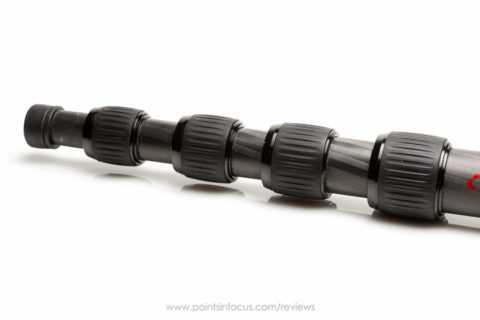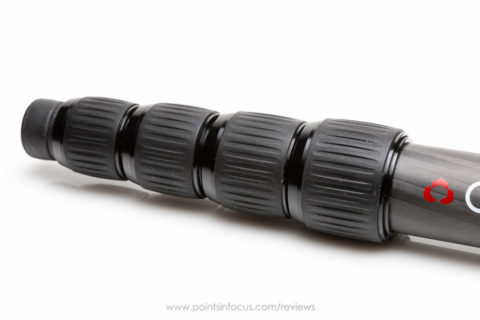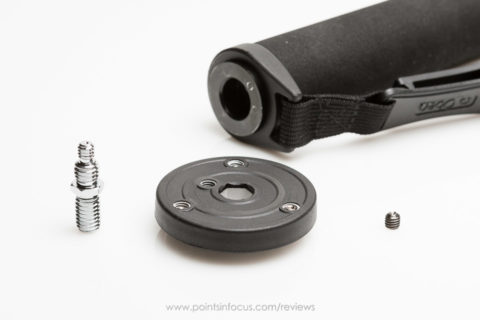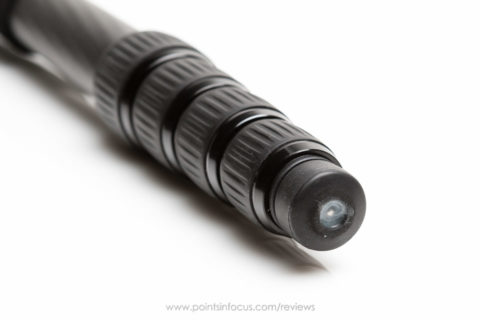Oben CTM-2500 Monopod Review
Let me start this by straight up saying I’m a Gitzo/Really Right Stuff guy. I shot with a pro or semi-pro DSLR and pro lenses, and that means I can have upwards of $8000–$10,000 of gear on top of my monopod or tripod. When looking at a replacement bill that high I’m not at all bothered by the idea of putting out $300–$400 on a monopod if that means I won’t see my camera plummeting to the ground because a corner was cut in design or quality control to make a cheaper product.
On the other hand, a monopod isn’t a nuclear reactor; it’s a handful of tubes and some hardware to hold it all together. Given that, it’s hard not to wonder what Gitzo is doing that makes their monopods cost $300 versus the $90 to $150 of many of the the recent entries to the market space
That said, the idea of an inexpensive carbon fiber monopod intrigues me. Worst case it’s $90 mistake, and while I don’t like throwing away money, that’s at least a sum that I can live with. A little better than that, is that it’s cheap enough that I have no problems cutting into the thing to modify it to be exactly what I want. Best case, it’s exactly what I want right out of the box — this didn’t happen.
With that said, lets talk a little about why I picked the Oben CTM–2500 and not something else.
Picking a Monopod
There are a couple of considerations you want to make before going into a monopod. These include: material, type of leg locks, number of leg sections, load capacity, extended length, and collapsed length.
Of those, the biggest factor you want to consider is the extended length. You absolutely want a monopod, or tripod, that’s tall enough that you can look through the camera’s viewfinder without bending over. Many companies sell travel monopods that collapse down real short, but unless you’re short too, you’ll find you have to constantly bend over to use them. Actually, what you really want is a monopod that’s taller than just eye-level, as there may be times when the ground slopes away and you’re back to bending over again.
The second major factor is that your monopod supports the weight of your gear. About the only real consideration here is to insure that there’s plenty of margin both for safety and to maximize stability.
Beyond the extended length and capacity most of the rest of the factors are more of personal preference instead of a requirement.
Material: There are basically 2 viable options at this point for materials: aluminum and carbon fiber. Aluminum is generally cheaper. However, it flexes more and is much less comfortable to handle in cold weather. Carbon fiber is more rigid, slightly lighter, and doesn’t have the cold weather problems. However it’s harder to get right and generally is more expensive.
Collapsed Length: Shorter is easer to pack and travel with, but usually means more sections.
Number of Sections: More sections usually allow the monopod to collapse down to a smaller package, but cost some stability and load capacity. Moreover, the more sections there are the more sections that have to be adjusted between standing and sitting or kneeling.
Leg locks: Twist locks are somewhat simpler in design and better ergonomically since there’s no preferred orientation. Moreover, they don’t require tools to maintain or adjust. However, some people find they’re slower than flip locks for making adjustments.
My needs and preferences are as follows:
1. 60–65 inches extended length, so I don’t have to bend over even if I’m working on a slope
2. A capacity to hold at least 10–15 pounds of gear (which means for me a published limit of close to 30 pounds to be safe)
3. Carbon fiber: for the weight, stiffness, and comfort of handing in the cold
4. Twist locks: for the easy of use and to match what I’m already use to on my tripod
5. as compact as possible collapsed for traveling
After considering the options, most of the monopods that satisfied points 1 through 4 were 20–22 inches long when collapsed. This is certainly better than the 25 of my previous monopod, but there were two options that stood out. The $90 Oben CTM–2500 and the $400 Gitzo GM5561T.
For $90, it was hard not to give the Oben a once over.
The Oben CTM–2500
The CTM–2500 is a 5-section carbon fiber monopod. Collapsed it’s just 17 inches (43 cm) long, and fully extended it reaches 65 inches (165 cm). Overall it weighs right around 1 pound (0.45 kg), and is rated to support 27 pounds (12.25 kg). That said, in vertical loading and with the leg-locks properly tightened, the CTM–2500 can support considerably more than 27 pounds without slipping.
Of course, the more you load a monopod, the more it will struggle with stability and vibration. So while you could certainly put 50 pounds of gear on the CTM–2500 and it probably won’t collapse under that, you wouldn’t want to. However, for the typical 5–15 pounds of a pro camera and big zoom or super-telephoto prime the load limit is adequate.
The 5 sections vary in diameter from 1–1/4 inch at the top to 3/4 inch at the bottom, with intermediate steps of 1–1/8 in., 1 in., and 7/8 in. That said it’s hard to judge the quality of a carbon fiber tube from looks alone. However, a visual inspection didn’t reveal any obvious defects or delaminations in the tubes on this tripod.

That said, the legs do flex some, especially the smallest tubes at the bottom of the monopod, though this can be mitigated some by not extending them fully and making sure the lock is fully tightened down. That said, there’s no more flex in this 5-section carbon fiber monopod than there is in the 3-section aluminum Manfrotto it’s replacing. All told, I really don’t see a big issue with the little bit of flex that’s there.
Oben uses twist style leg locks on the CTM–2500, which is a big plus in my book. I vastly prefer twist style locks over flip locks (like Manfrotto uses) because there isn’t a preferred orientation. No matter which way the monopod is pointed, the locks are just as accessible and work just the same. Moreover, or perhaps more importantly, no tools are needed to adjust the tightness of the locks nor will they become looser with use, both problems that are common with flip lock designs I’ve used in the path.

The legs are also equipped with an anti-rotation system that’s virtually identical to what my Gitzo tripod uses. Aside from the nicety of not having the legs rotate, the anti-rotation system makes it possible to lock and unlock multiple locks simultaneously.

The locks themselves are surprisingly good too, they’re not that far from the quality of my Gitzo’s. They rotate smoothly, though they require a larger amount of rotation than the ones on a Gitzo product does. If anything, the biggest deficiency in the locking system is that they need to be turned further than I’m accustom to with to allow the sections to slide fully and easily.
All told, I can’t find much wrong with the leg sections and the locks themselves.
With the leg itself covered, I want to turn my attention to the two extremities. To top plate is pretty standard for a good quality monopod. It’s cast metal and the stud is reversible supporting both 1/4–20 and 3/8–16 mountings. The mounting stud subsequently secures the top plate and the head to the top section via a 3/8–16 threaded socket in the top fitting. Subsequently the top plate and stud can be locked in place with a 3mm hex set screw.

The only real outstanding question, is how well the entire top assembly is attached to carbon fiber tube. There are a pair of pins at the top of the tube that are visible if you look carefully under the ring that attaches the hand strap. Hopefully that’s also backed up with an epoxy/glued joint internally as well, or I would have some reservations about the long term stability of this joint. Either way, the top assembly seems to be solidly fixed to the top tube on mine.
The design of whole top plate assembly is pretty standard for a higher end monopod. If you look at a Gitzo for example, you’ll see they’re designed much these same way.
About my only gripe with the top plate is that if you, like me, want to use a smaller diameter head, say a Manfrotto 234 tilt head, or a Really Right Stuff BH–25 you can’t secure it with the set screws in the plate since they’re too far away from the center.

Though I’ve been pretty impressed by the build of the entire monopod so far, the foot is an entirely different story. The rubber with retracting spike foot Oben used is by far my least favorite part of the monopod — and this is not a trivial aversion for me either.
To start with, I never use spiked feet. There’s no surface I shoot on where one has ever provided me with better footing than a rubber foot, and there are plenty of surfaces where I’m concerned that a metal spike could cause damage (and know of several places that will flat out prohibit you from using this kind of foot due to damage to membrane roofs in the past). Moreover, the hole in the rubber for the spike eliminates a lot of rubber from the bottom center of the foot, right where the foot contacts the ground the most, and right where the rubber is going to wear the most.
Wear on the foot leads me to my bigger concern in the long run — serviceability.
I don’t see anything in the build of the rest of the monopod that makes me thing it will break after a couple of uses. Heck it comes with a 5 year warranty, so Oben expects them to last for at least that long. However, feet are much closer to consumables than anything else is on a monopod. This is even more of an issue if you use them on hard rough surfaces, like concrete paths, frequently.
The high end manufacturers, like Gitzo and Really Right Stuff, approach this problem with the understanding that photographers shouldn’t need to get an RMA to replace or adjust the foot on their monopods. As a result, their legs end in a 3/8–16 threaded socket and their feet, all of the various kinds, have a 3/8–16 stud that then screws into the leg. If you wear out your foot, it’s a <$10 replacement part that you can thread on in 30 seconds.
On the other hand, the Oben CTM–2500 lacks any ability to remove and replace the foot assembly. What should be a 5 second operation of unscrewing one foot and screwing in a new one, is a warranty call or simply replacing the monopod as a whole.
The other advantage of having a threaded socket in the bottom of a monopod is that it then becomes possible to use the monopod as an impromptu microphone boom. Thread a 3/8–16 double ended stud into the socket and thread on to that a shock mount or DSLR video mice (like a Rhode Video Mic Pro). A 65 inch monopod is pretty short for a mic boom, but it can be long enough to use in a pinch when shooting location video with a VDSLR.
My misgivings with the foot on the CTM–2500 were born out when mine broke while I was attempting to extend the spike to measure it for this review. Now I certainly could return it and get a replacement, which was Oben’s support’s recommendation. However, I consider this something of a mixed blessing. Namely, I now have an excuse to remove the Oben foot and replace it with a threaded insert and a nice fat Really Right Stuff foot. While I certainly wouldn’t recommend everyone go about this option, and I’d really rather Oben just sell the thing with a 3/8–16 threaded foot mount, this is probably the second best thing for me.
Other Options and Conclusions
The real trick that Oben has here is that at least the CTM–2500 really stands alone in the combination of size and capacity.
The closes options from Really Right Stuff are their recently announced MC–14 and MC–24. Both have equal or better rated load capacities than the CTM–2500. However, both are only 4 section monopods and end up being considerably shorter when extended.
Gitzo straddles the CTM–2500 in both directions but in both cases you do make compromises. The CTM–2500 falls between the Gitzo GM2561T the GM2541. The GM2561T traveler is 3 inches shorter when collapsed, and nearly as tall when extended, but rated for less than half of the load as the CTM–2500. The GM2541 matches the Oben’s load rating, but is 3“ longer when collapsed and 2” shorter when fully extended. Finally, there’s the GM5561T which will hold more and collapses shorter, but is just under 4 inches shorter extended, and is a 6 section model.
In the end the CTM–2500 is really frustrating to me. It’s in a size and capacity class that I can’t really match with a Gitzo or Really Right Stuff product, and certainly not for the money. Moreover, it’s about the ideal range for me. However, the foot is a huge issue for me, and the overall robustness of the product remains to be seen. Had Oben used a screw in 3/8–16 foot like Gitzo and Really Right Stuff do, this would be an easy recommendation for all but the most demanding users. As it stands, it’s certainly worth a look, but my recommendation isn’t so clear cut.

Comments
There are no comments on this article yet. Why don't you start the discussion?